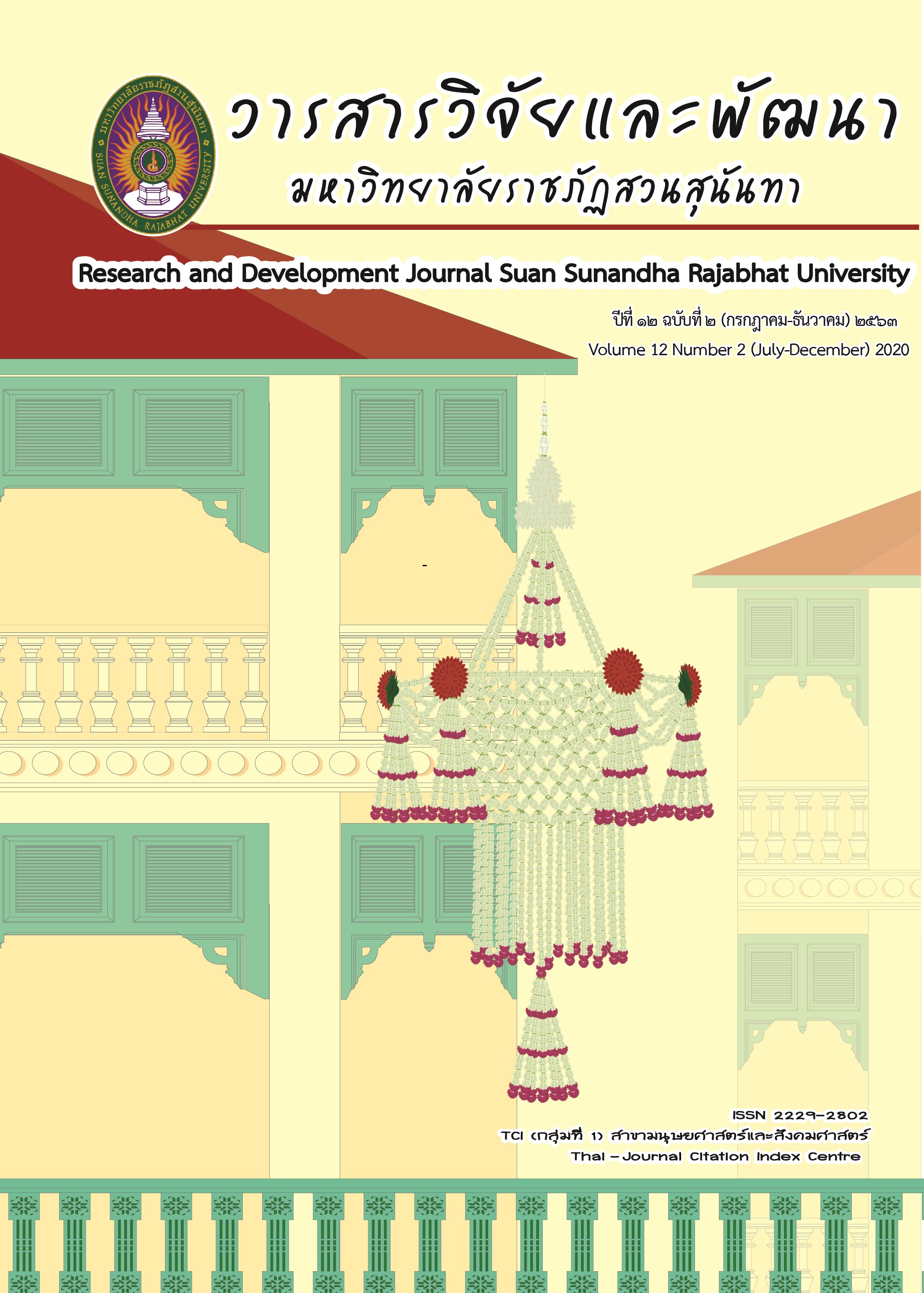การพัฒนาผลสัมฤทธิ์ทางการเรียน เรื่อง พันธุกรรม ด้วยไมโครเลิร์นนิง สำหรับนักเรียนระดับชั้นมัธยมศึกษาปีที่ 3
DOI:
https://doi.org/10.53848/irdssru.v12i2.242463คำสำคัญ:
ไมโครเลิร์นนิง, ผลสัมฤทธิ์ทางการเรียน, พันธุกรรม, มัธยมศึกษาปีที่ 3บทคัดย่อ
การวิจัยนี้มีวัตถุประสงค์ เพื่อสร้างไมโครเลิร์นนิง เรื่อง พันธุกรรม สำหรับนักเรียนชั้นมัธยมศึกษาปีที่ 3 ให้มีประสิทธิภาพและวัดประสิทธิผลหลังจากใช้ กลุ่มตัวอย่างได้มาจากการเลือกแบบเจาะจง จากนักเรียนระดับชั้นมัธยมศึกษาปีที่ 3 ปีการศึกษา 2562 จำนวน 149 คน เครื่องมือที่ใช้ในทดลอง ได้แก่ ไมโครเลิร์นนิง เรื่อง พันธุกรรม สำหรับนักเรียนระดับชั้นมัธยมศึกษาปีที่ 3 และเครื่องมือที่ใช้ในเก็บข้อมูล ได้แก่ 1. แบบทดสอบวัดผลสัมฤทธิ์ทางการเรียน วิเคราะห์ข้อมูลโดยการหาค่าเฉลี่ย ค่าความเบี่ยงเบนมาตรฐาน และทดสอบทีของกลุ่มตัวอย่างแบบไม่อิสระกัน 2. แบบสอบถามความคิดเห็นของนักเรียนที่มีต่อไมโครเลิร์นนิง วิเคราะห์ข้อมูลโดยการหาค่าเฉลี่ย ค่าความเบี่ยงเบนมาตรฐาน และทดสอบทีแบบกลุ่มตัวอย่างเดียวเทียบกับเกณฑ์ (µ = 3.50) พบว่า 1) ไมโครเลิร์นนิงที่ผู้วิจัยสร้างขึ้นมีประสิทธิภาพ เท่ากับ 85.87/84.67 ซึ่งสูงกว่าเกณฑ์ที่กำหนดไว้ 80/80 2) นักเรียนมีผลสัมฤทธิ์ทางการเรียนหลังเรียนด้วยไมโครเลิร์นนิงสูงกว่าก่อนเรียนอย่างมีนัยสำคัญทางสถิติที่ระดับ .01 และ 3) นักเรียนมีความคิดเห็นต่อไมโครเลิร์นนิงอยู่ในระดับมาก และสูงกว่าเกณฑ์อย่างมีนัยสำคัญทางสถิติที่ระดับ .01
เอกสารอ้างอิง
Arsingsamnan, W., Sawangmek, S., & Nakkuntod, M. (2018). An Action Research for Enhancing Genetics Conception of Grade 10 Students by Learning Management Using Scientific Argumentation in Socioscientific Issues. Social Sciences Research and Academic Journal, 12(35), 87 – 100.
Giurgiu, L. (2017). Micro learning an Evolving ELearning Trend. Scientific Bulletin, 1 (43), 18 – 23.
Hug, T., Gassler, G., Glahn, C. (2004). Integrated Micro learning – An Outline of the basic method and first results. In Auer, E. & Auer, U. (Eds.). Proceedings of international conference on Interactive Computer Aided Learning, (pp. 1-7). Vallach, Austria.
Institute for the Promotion of Teaching Science and Technology. (2017). Handbook of the Implementation Curriculum on the Basic Science for lower Secondary school. Bangkok: Institute for the Promotion of Teaching Science and Technology.
Javorcik, T., & Polasek, R. (2019). Comparing the Effectiveness of Microlearning and eLearning Courses in the Education of Future Teachers. In Jakab F. (Ed.), Proceedings of the 17th International Conference on Emerging eLearning Technologies and Applications (ICETA), (pp. 309 – 314). Slovakia: Stary Smokovee, the High TaTras.
Kongsomboon, L. (2019). Development of Microlearning for High Vocational Certificate Private Vocational College in Bangkok. Academic Journal Bangkokthonburi University, 8 (2), 51 – 62.
Ministry of Education, Thailand. (2010). The Guidelines of learning management in accordance with the basic education core curriculum B.E. 2551 (A.D. 2008). Bangkok: The Agricultural Cooperative Federation of Thailand, Limited.
Mohammed, G., Wakil, K., & Nawroly, S. (2018). The effectiveness of microlearning to improve students’ learning ability. International Journal of Educational Research Review, 3 (3), 32 – 38.
Pandey, A. (2019, June 10). The Benefits of Micro learning – Based Training (2016). Retrieved from https://elearningindustry.com/10-benefits-microlearning-based-training.
Ritcharoon, P. (2010). Research technique for learning development. Bangkok: Chulalongkorn University Press.
Rukchaipanit, V. (2015). Creativity-based Learning (CBL). Walailak Journal of Learning Innovations, 1(2), 23 – 37.
ดาวน์โหลด
เผยแพร่แล้ว
รูปแบบการอ้างอิง
ฉบับ
ประเภทบทความ
สัญญาอนุญาต
บทความที่ได้รับการตีพิมพ์เป็นลิขสิทธิ์ของ สถาบันวิจัยและพัฒนา มหาวิทยาลัยราชภัฎสวนสุนันทา
ข้อความที่ปรากฏในบทความแต่ละเรื่องในวารสารวิชาการเล่มนี้เป็นความคิดเห็นส่วนตัวของผู้เขียนแต่ละท่านไม่เกี่ยวข้องกับมหาวิทยาลัยราชภัฎสวนสุนันทา และคณาจารย์ท่านอื่นๆในมหาวิทยาลัยฯ แต่อย่างใด ความรับผิดชอบองค์ประกอบทั้งหมดของบทความแต่ละเรื่องเป็นของผู้เขียนแต่ละท่าน หากมีความผิดพลาดใดๆ ผู้เขียนแต่ละท่านจะรับผิดชอบบทความของตนเองแต่ผู้เดียว





